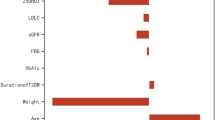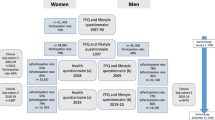Abstract
Summary
Pioglitazone use is associated with an increased risk of fractures. In this randomized, placebo-controlled study, pioglitazone use for 12 months was associated with a significant increase in bone marrow fat content at the femoral neck, accompanied by a significant decrease in total hip bone mineral density. The change in bone marrow fat with pioglitazone use was predominantly observed in female vs. male participants.
Introduction
Use of the insulin sensitizer pioglitazone is associated with greater fracture incidence, although the underlying mechanisms are incompletely understood. This study aimed to assess the effect of pioglitazone treatment on femoral neck bone marrow (BM) fat content and on bone mineral density (BMD), and to establish if any correlation exists between the changes in these parameters.
Methods
In this double-blind placebo-controlled clinical trial, 42 obese volunteers with metabolic syndrome were randomized to pioglitazone (45 mg/day) or matching placebo for 1 year. The following measurements were conducted at baseline and during the treatment: liver, pancreas, and femoral neck BM fat content (by magnetic resonance spectroscopy), BMD by DXA, abdominal subcutaneous and visceral fat, and beta-cell function and insulin sensitivity.
Results
Results were available for 37 subjects who completed the baseline and 1-year evaluations. At 12 months, BM fat increased with pioglitazone (absolute change, +4.1%, p = 0.03), whereas BM fat content in the placebo group decreased non-significantly (−3.1%, p = 0.08) (p = 0.007 for the pioglitazone–placebo response difference). Total hip BMD declined in the pioglitazone group (−1.4%) and increased by 0.8% in the placebo group (p = 0.03 between groups). The change in total hip BMD was inversely and significantly correlated with the change in BM fat content (Spearman rho = −0.56, p = 0.01) in the pioglitazone group, but not within the placebo group (rho = −0.29, p = 0.24). Changes in BM fat with pioglitazone were predominantly observed in female vs. male subjects.
Conclusions
Pioglitazone use for 12 months compared with placebo is associated with significant increase in BM fat content at the femoral neck, accompanied by a small but significant decrease in total hip BMD.



Similar content being viewed by others
References
Yki-Jarvinen H (2004) Thiazolidinediones. N Engl J Med 351:1106–1118. doi:10.1056/NEJMra041001
Olefsky JM (2000) Treatment of insulin resistance with peroxisome proliferator-activated receptor gamma agonists. J Clin Invest 106:467–472. doi:10.1172/JCI10843
Bajaj M, Suraamornkul S, Hardies LJ et al (2004) Plasma resistin concentration, hepatic fat content, and hepatic and peripheral insulin resistance in pioglitazone-treated type II diabetic patients. Int J Obes Relat Metab Disor 28:783–789. doi:10.1038/sj.ijo.0802625
Tiikkainen M, Hakkinen AM, Korsheninnikova E et al (2004) Effects of rosiglitazone and metformin on liver fat content, hepatic insulin resistance, insulin clearance, and gene expression in adipose tissue in patients with type 2 diabetes. Diabetes 53:2169–2176. doi:10.2337/diabetes.53.8.2169
McGavock JM, Lingvay I, Zib I et al (2007) Cardiac steatosis in diabetes mellitus: a 1H-magnetic resonance spectroscopy study. Circulation 116:1170–1175. doi:10.1161/CIRCULATIONAHA.106.645614
Maalouf NM (2015) Impact of anti-hyperglycemic medications on bone health. Clinic Rev Bone Miner Metab 13:43–52
Kahn SE, Zinman B, Lachin JM et al (2008) Rosiglitazone-associated fractures in type 2 diabetes: an analysis from a diabetes outcome progression trial (ADOPT). Diabetes Care 31:845–851. doi:10.2337/dc07-2270
Kahn SE, Haffner SM, Heise MA et al (2006) Glycemic durability of rosiglitazone, metformin, or glyburide monotherapy. N Engl J Med 23:2427–2443. doi:10.1056/NEJMoa066224
FDA. Observation of an increased incidence of fractures in female patients who received long-term treatment with pioglitazone. http://www.fda.gov/downloads/safety/medwatch/safetyinformation/safetyalertsforhumanmedicalproducts/ucm153896.pdf
Home PD, Pocock SJ, Beck-Nielsen H et al (2009) Rosiglitazone evaluated for cardiovascular outcomes in oral agent combination therapy for type 2 diabetes (RECORD): a multicentre, randomised, open-label trial. Lancet 373:2125–2135. doi:10.1016/S0140-6736(09)60953-3
Zhu ZN, Jiang YF, Ding T (2014) Risk of fracture with thiazolidinediones: an updated meta-analysis of randomized clinical trials. Bone 68:115–123. doi:10.1016/j.bone.2014.08.010
Aubert RE, Herrera V, Chen W et al (2010) Rosiglitazone and pioglitazone increase fracture risk in women and men with type 2 diabetes. Diabetes Obes Metab 12:716–721. doi:10.1111/j.1463-1326.2010.01225.x
Colhoun HM, Livingstone SJ, Looker HC et al (2012) Hospitalised hip fracture risk with rosiglitazone and pioglitazone use compared with other glucose-lowering drugs. Diabetologia 55:2929–2937. doi:10.1007/s00125-012-2668-0
Rzonca SO, Suva LJ, Gaddy D et al (2004) Bone is a target for the antidiabetic compound rosiglitazone. Endocrinology 145:401–406. doi:10.1210/en.2003-0746
Wan Y, Chong LW, Evans RM (2007) PPAR-gamma regulates osteoclastogenesis in mice. Nature Med 13:1496–1503. doi:10.1038/nm1672
Grey A, Bolland M, Gamble G et al (2007) The peroxisome proliferator-activated receptor-gamma agonist rosiglitazone decreases bone formation and bone mineral density in healthy postmenopausal women: a randomized, controlled trial. J Clin Endocrinol Metab 92:1305–1310. doi:10.1210/jc.2006-2646
Executive summary of the third report of the National Cholesterol Education Program (NCEP) expert panel on detection, evaluation, and treatment of high blood cholesterol in adults (Adult Treatment Panel III). JAMA 285:2486–2497
Warshauer J, Lopez X, Gordillo R et al (2015) Effect of pioglitazone on plasma ceramides in adults with metabolic syndrome. Diabetes Metab Res Rev 31:734–744. doi:10.1002/dmrr.2662
Szczepaniak LS et al (1999) Measurement of intracellular triglyceride stores by 1H spectroscopy: validation in vivo. Am J Physiol Endocrinol Metab 276:977–989
Szczepaniak LS, Nurenberg P, Leonard D et al (2005) Magnetic resonance spectroscopy to measure hepatic triglyceride content: prevalence of hepatic steatosis in the general population. Am J Physiol Endocrinol Metab 288:E462–E468. doi:10.1152/ajpendo.00064.2004
Lingvay I, Esser V, Legendre JL et al (2009) Noninvasive quantification of pancreatic fat in humans. J Clin Endocrinol Metab 94:4070–4076. doi:10.1210/jc.2009-0584
Griffith JF, Yeung DK, Chow SK et al (2009) Reproducibility of MR perfusion and 1H spectroscopy of bone marrow. J Magn Reson Imaging 29:1438–1342. doi:10.1002/jmri.21765
Billington EO, Grey A, Bolland MJ (2015) The effect of thiazolidinediones on bone mineral density and bone turnover: systematic review and meta-analysis. Diabetologia 58:2238–2246. doi:10.1007/s00125-015-3660-2
Grey A, Beckley V, Doyle A et al (2012) Pioglitazone increases bone marrow fat in type 2 diabetes: results from a randomized controlled trial. Eur J Endocrinol 166:1087–1091. doi:10.1530/EJE-11-1075
Harsløf T, Wamberg L, Møller L et al (2011) Rosiglitazone decreases bone mass and BM fat. J Clin Endocrinol Metab 96:1541–1548. doi:10.1210/jc.2010-2077
Berberoglu Z, Gursoy A, Bayraktar N et al (2007) Rosiglitazone decreases serum bone-specific alkaline phosphatase activity in postmenopausal diabetic women. J Clin Endocrinol Metab 92:3523–3530. doi:10.1210/jc.2007-0431
Grey A (2009) Thiazolidinedione-induced skeletal fragility–mechanisms and implications. Diab Obes Metab 11:275–284. doi:10.1111/j.1463-1326.2008.00931.x
Gruntmanis U, Fordan S, Ghayee HK et al (2010) The peroxisome proliferator-activated receptor gamma agonist rosiglitazone increases bone resorption in women with type 2 diabetes: a randomized, controlled trial. Calcif Tis Int 86:343–349. doi:10.1007/s00223-010-9352-5
Bilezikian JP, Josse RG, Eastell R et al (2013) Rosiglitazone decreases bone mineral density and increases bone turnover in postmenopausal women with type 2 diabetes mellitus. J Clin Endocrinol Metab 98:1519–1528. doi:10.1210/jc.2012-4018
Bone HG, Lindsay R, McClung MR et al (2013) Effects of pioglitazone on bone in postmenopausal women with impaired fasting glucose or impaired glucose tolerance: a randomized, double-blind, placebo-controlled study. J Clin Endocrinol Metab 98:4691–4701. doi:10.1210/jc.2012-4096
Grey A, Bolland M, Fenwick S et al (2014) The skeletal effects of pioglitazone in type 2 diabetes or impaired glucose tolerance: a randomized controlled trial. Eur J Endocrinol 170:255–262. doi:10.1530/EJE-13-0793
Dormandy J, Bhattacharya M, van Troostenburg de Bruyn AR (2009) Safety and tolerability of pioglitazone in high-risk patients with type 2 diabetes: an overview of data from PROactive. Drug Saf 32:187–202. doi:10.2165/00002018-200932030-00002
Fazeli PK, Horowitz MC, MacDougald OA et al (2013) Marrow fat and bone--new perspectives. J Clin Endocrinol Metab 98:935–945. doi:10.1210/jc.2012-3634
Benvenuti S, Cellai I, Luciani P et al (2012) Androgens and estrogens prevent rosiglitazone-induced adipogenesis in human mesenchymal stem cells. J Endocrinol Investig 35:365–371. doi:10.3275/7739
Seto-Young D, Avtanski D, Parikh G et al (2011) Rosiglitazone and pioglitazone inhibit estrogen synthesis in human granulosa cells by interfering with androgen binding to aromatase. Horm Metab Res 43:250–256. doi:10.1055/s-0030-1270525
Sahi J, Black C, Hamilton G et al (2003) Comparative effects of thiazolidinediones on in vitro p450 enzyme induction and inhibition. Drug Metab Dispos 31:439–446. doi:10.1124/dmd.31.4.439
Tsuchiya Y, Nakajima M, Yokoi T (2005) Cytochrome P450-mediated metabolism of estrogens and its regulation in human. Cancer Lett 227:115–124. doi:10.1016/j.canlet.2004.10.007
Hirose JH, Kawai T, Yamamoto Y et al (2002) Effects of pioglitazone on metabolic parameters, body fat distribution, and serum adiponectin levels in Japanese male patients with type 2 diabetes. Metabolism 51:314–317. doi:10.1053/meta.2002.30506
Kudoh A, Satoh H, Hirai H et al (2011) Pioglitazone upregulates adiponectin receptor 2 in 3T3-L1 adipocytes. Life Sci 88:1055–1062. doi:10.1016/j.lfs.2011.04.001
Berner HS, Lyngstadaas SP, Spahr A et al (2004) Adiponectin and its receptors are expressed in bone-forming cells. Bone 35:842–849. doi:10.1016/j.bone.2004.06.008
Liu Y, Song CY, Wu SS et al (2013) Novel adipokines and bone metabolism. Int J Endocrinol. doi:10.1155/2013/895045
Takano T, Li YJ, Kukita A et al (2014) Mesenchymal stem cells markedly suppress inflammatory bone destruction in rats with adjuvant-induced arthritis. Lab Investig 94:286–296. doi:10.1038/labinvest.2013.152
Park JS, Cho MH, Nam JS et al (2011) Effect of pioglitazone on serum concentrations of osteoprotegerin in patients with type 2 diabetes mellitus. Eur J Endocrinol 164:69–74. doi:10.1530/EJE-10-0875
Thommesen L, Stunes AK, Monjo M et al (2006) Expression and regulation of resistin in osteoblasts and osteoclasts indicate a role in bone metabolism. J Cell Biochem 99:824–834. doi:10.1002/jcb.20915
Patsch JM, Xiaojuan L, Baum T et al (2013) Bone marrow fat composition as a novel imaging biomarker in postmenopausal women with prevalent fragility fractures. J Bone Miner Res 28:1721–1728. doi:10.1002/jbmr.1950
Yu EW, Thomas BJ, Brown JK et al (2012) Simulated increases in body fat and errors in bone mineral density measurements by DXA and QCT. J Bone Miner Res 27:119–124. doi:10.1002/jbmr.506
Acknowledgments
The authors would like to thank Madhuri Poduri, MS (Department of Internal Medicine, UTSW) for her expert help in protocol implementation, patient care, and data collection. The authors would also like to express their gratitude to all the study volunteers and UTSW Hospital Staff.
Author information
Authors and Affiliations
Corresponding author
Ethics declarations
Funding sources
This work was supported by the National Institutes of Health grants: RR024476 and RR024982.
Conflicts of interest
Ildiko Lingvay received consultant/research grants from Novo Nordisk; consultant from AstraZeneca, Lilly, and Sanofi; and research grant from GI Dynamics and Pfizer/Merck and publication support from AstraZeneca, Boehringer Ingelheim, Novo Nordisk, and Sanofi. The remaining authors have nothing to disclose.
Ethical approval
All procedures performed in the present study involving human participants were approved by the University of Texas at Southwestern Medical Center at Dallas (TX) Institutional Review Board and have been performed in accordance with the ethical standards as laid down in the 1964 Declaration of Helsinki and its later amendments or comparable ethical standards.
Informed consent
Informed consent was obtained from all individual participants in the study.
Electronic supplementary material
ESM 1
(DOCX 12 kb)
Rights and permissions
About this article
Cite this article
Pop, L.M., Lingvay, I., Yuan, Q. et al. Impact of pioglitazone on bone mineral density and bone marrow fat content. Osteoporos Int 28, 3261–3269 (2017). https://doi.org/10.1007/s00198-017-4164-3
Received:
Accepted:
Published:
Issue Date:
DOI: https://doi.org/10.1007/s00198-017-4164-3




